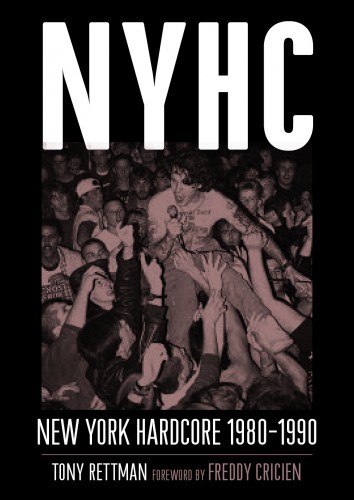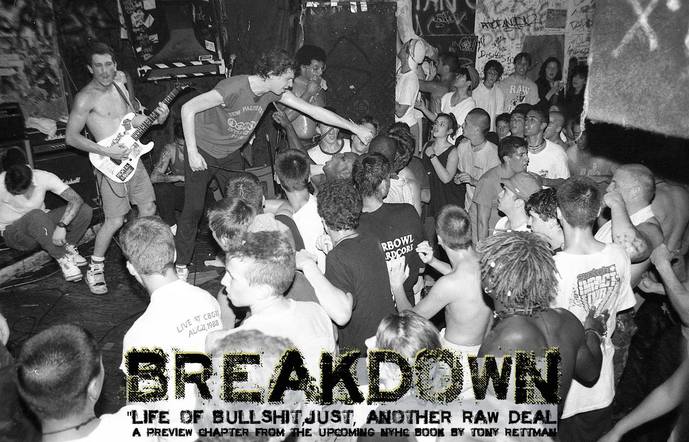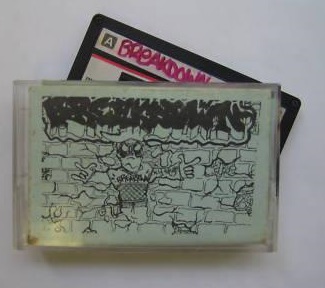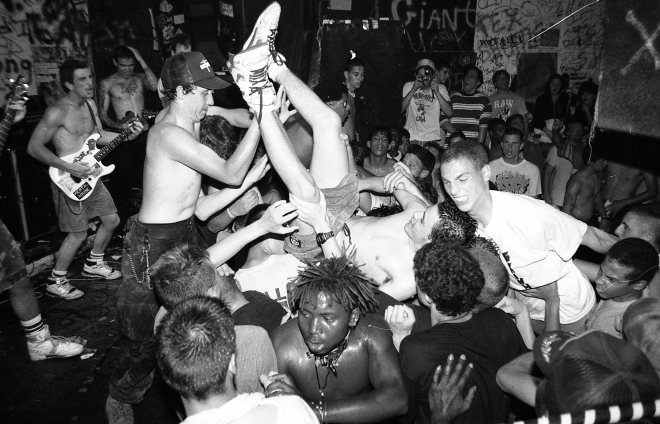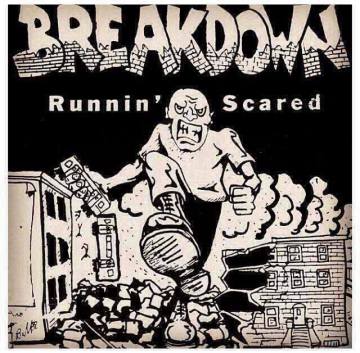NYHC: NEW YORK HARDCORE 1980-1990 BY: TONY RETTMAN
COMING DECEMBER 16, 2014 TO A STORE NEAR YOU
NYHC New York Hardcore 1980-1990 is a new book by Tony Rettman which will be coming out in December via Bazillion Points Publishing. We were fortunate enough to get a preview chapter from Tony and here it is. Chapter 43 titled "Breakdown: Life Of Bullshit-Just Another Raw Deal". In this chapter we get the lowdown on why the original members decided to split up which ended up spawning Raw Deal who later changed their name to Killing Time. At the end there are event links to book signings with author Tony as well as with Sean Taggart and Mike Judge with more events (not announced yet) to follow.
43. BREAKDOWN: LIFE OF BULLSHIT—JUST ANOTHER RAW DEAL
Carl Porcaro: Breakdown was started by me and my friend Don Angelilli. We started getting into hardcore in the mid ’80s. Back then, you could pretty much identify someone who was into hardcore by what they wearing; like patches or T-shirts or whatever. There was a small crew around Yonkers who found themselves that way, and through a record store called Mad Platters. Bill Wilson who started Blackout Records was a lifeguard at the public pool in Yonkers, and Don hung out there too. I think that’s where they met Rich McCloughin. That’s pretty much how Breakdown came together. We started jamming in my parents’ basement or Rich’s garage, and then we settled into Drago’s garage and spent decades there.
Anthony Drago: The early Breakdown line-up started in 1986 and lasted a year or even less than that. The drummer wasn’t cutting it, so I slid in there. The next week, we had three songs down: “Your Problems,” “Vengeance,” and “Life of Bullshit.” The lyrics Jeff was writing were real tough guy shit. I guess that was different, because I think Breakdown is considered one of the first “tough guy” bands to come out of New York.
Jeff Perlin: When Breakdown first started playing, the Sick of It All demo had just come out a few months earlier. Sheer Terror was still slogging it out with demos trying to make a name for themselves. The Krakdown demo had just come out, along with Leeway's "Enforcer" demo, plus Rest in Pieces, and stuff like that. Some of the original NYHC bands were slowly disappearing, like Major Conflict, Reagan Youth, and Antidote. Around 1986 and 1987 a whole new wave of bands emerged that were influenced by all the original New York bands but also added something new.
Anthony Drago: We had the music together for that whole first demo within four weeks. We played in Connecticut and VFW Halls in upstate New York, bingo halls, or whatever. We played a decent amount of shows in that small time. Rich made our shirts himself. He used to work at a T-shirt factory in White Plains. We paid for the ink, and his boss let us do the shirts there. It was some real do-it-yourself shit.
Bill Wilson: Carl Porcaro was my best friend and he’s the founding member of Breakdown. I would go to all their practices. I drew a couple of the T-shirts and some of the stickers. That’s how I got my start working with bands. I did that logo with the bricks, sitting at Carl’s kitchen table with a Sharpie.
Jeff Perlin: Bill was there from the first practice, and he went to every show, every practice. We'd hang out all the time, go to Fuddrucker's to get huge burgers, then go to Don's house or my place. Bill really helped to get things going for us.
Anthony Drago: We had to get up enough songs to record, and then we had to get enough money to go somewhere and record a four-track demo. That was the only way people were going to hear us. The 1987 demo was recorded at this place called the Loft, a recording studio in Bronxville owned by Al Hemberger. It was more of a hippy scene there at The Loft, so we were one of the crazier bands they recorded there. After us, a lot of bands started finding out about it, so he got more of a punk rock clientele.
Carl Porcaro: We recorded everything live with one take. It worked out for us. There was this hippie guy behind the board who had no clue what we were doing. He seemed annoyed, but it all worked out. It was all about cheap guitars and cheap amps and a lot of energy and having all your boys in the studio singing background vocals. It was a free-for-all.
Anthony Drago: We copied all the demo tapes ourselves and brought them down to Duane at Some Records. Maybe we were one of the lucky ones, or maybe we were just good; I don’t know. But he was selling it like crazy and we were getting good gigs right off the bat.
Jeff Perlin: Any show at CBGB was great. I guess we were most excited about our first show there. They booked us with Uniform Choice, which was a really popular band at the time. The show was packed and we got a really good reaction. Our first shows there and at the Anthrax in Connecticut really made us feel like maybe we were doing something special, and that it was worth moving forward with the band.
Our first real show was a benefit at The Anthrax to keep the club open. This was our first show at a club that had hardcore shows on a regular basis and all of us were really nervous. We weren't sure if we were gonna be kicked off the stage. We had no idea if people would like us or not. But it was nuts. I don't want to sound like an egotistical asshole, but seriously—we kicked off with “Sick People” and the place just went berserk! I mean, the place was jam-packed, and the whole club turned into a giant pit. The kids went crazy for us for the whole set. It was like we were dreaming; it was unreal. Jim Gibson, who started Noiseville Records, was our roadie; he is this really big biker-looking dude with a heart of gold. When I came off the stage he was just beaming! He had tears in his eyes. It was a great night, I don't think any of us will forget that.
Anthony Drago: Everything with the first line-up of Breakdown happened within the first nine or ten months of knowing each other. Things all happened so quickly and then we ended up breaking up. The original beef was between Rich McLoughlin and Don Angelilli. It was girl thing. Somebody said they saw Rich with this girl. Don was pissed, and he talked to Jeff, who agreed that was fucked up. Then Rich talked to me, and I agreed that things were fucked up for him, and that split the band in two camps there.
Carl Porcaro: There was clearly other shit brewing and that was used as the excuse for the break-up to happen. Things are different at that age. People get on your fucking nerves really easily. When you all have different ideas on what to do with the music, and, all of a sudden, one band member is hanging out in the backseat of a car with another band member’s girlfriend, things are set off. It all seems so silly in retrospect.
Jeff Perlin: I didn't even remember the reason why we broke up until we got back together with the original lineup recently. Two members were arguing over this girl, the band members took sides, and then we started bickering. It was stupid. Supposedly the girl wasn't much to argue over, either. They called her "Rocky Dennis." Rocky Dennis from Mask was cool, but I don't think I'd date him.
Carl Porcaro: Me, Rich and Drago just assumed we had just as much a right to play the songs as the other guys. There were three of us and only two of them! We had a show booked up at a VFW Hall in Albany with Gorilla Biscuits. We asked Steve Reddy, who was in the band Wolfpack and went on to run Equal Vision Records, to sing for Breakdown at that show. We played one gig like that.
Anthony Drago: So Don and Jeff continued with Breakdown with Mark Sisto on bass and Larry Kaplan on drums. They already had the name, so Breakdown went and kept on doing shows. Me, Rich, and Carl went back to my father’s garage. We had to start all over again. We just lost whatever fan base we had. From the beginning, all three of us really clicked together. We started writing music together, and it was so much better than what we were writing with Breakdown.
Carl Porcaro: We wondered what we going to do for a week or two and then we were down at Some Records and Duane said, “You should talk to Anthony Comunale, he’s looking for a band.” He came the day after Thanksgiving in 1987 to Drago’s backyard. We did the first Raw Deal demo in 1988.
Anthony Drago: Anthony Comunale had been on the hardcore scene much longer than we were. He was there from the beginning. He had the connections. People who saw him sing for Token Entry and Gilligan’s Revenge really wanted to see him in a new band. The first time we had him come down, he started singing “Telltale” and “One Other” and we had it together in seconds.
When Raw Deal first started, it was more of that tough guy attitude. We looked at the dark side rather than the bright side. We weren’t seeing anything great about life at that point. I was young and I was kind of pissed off about certain things. I didn’t write about social issues or problems of the world. My issue was with you. You talk behind my back. You’re stretching the truth. All those lyrics come from a very personal relationship I had with somebody who turned their back on me at one point in their life. There’s a lot of stuff with our lyrics that people take as a tough guy attitude, but the lyrics actually have more to do with girl problems.
The first Ritz show Raw Deal played, there was this great review: “They came out on stage, and three of them looked like little preppy kids, and the other two guys looked like two greasy jamokes you wouldn’t want to sit next to on the bus.” I thought that was a good start.
BOOK SIGNING EVENTS:
November 22, 2014 @ Natural Habitat in Asbury Park, NJ with artist Sean Taggart.
https://www.facebook.com/events/740985232615439
December 14, 2014 @ Vintage Vinyl in Fords, NJ with Mike Judge.
Pre-order NYHC with limited edition Sean Taggart artwork patch:
http://www.bazillionpoints.com/shop/nyhc-new-york-hardcore-1980-1990-by-tony-rettman
NYHC New York Hardcore 1980-1990 (Bazillion Point Publishing, Release Date December 16, 2014)
Review by: Chris Wynne
The New York Hardcore scene and the bands that made/make it up over the years are known throughout the world and are in some cases some of the biggest underground bands on the planet... but where did it all start? What was it like in the beginning stages and the years to follow?
Tony Rettman tackles what seemed to be an insurmountable task by taking the years 1980 through 1990 and went through them with a fine toothed comb by performing over 100 interviews with the big named players as well as the regular Joe's who altogether made NYHC what it is.
After a 2 page forward by Freddy "Madball" Cricien things open up in chapter 1 with the Stimulators and guitarist Denise Mercedes who bluntly says "there was no scene" when referring to the year 1980 and how these younger musicians were kind of coming into their own after the punk wave of bands like the Ramones had for the most part already done their thing. The events here are laid out in chronological order and the first bunch of chapters paint that tough image of NYC's Lower East Side where punk rockers and skinheads would often have to use their fists (and sometimes more) to get to and from shows alive in a predominately gang infested Puerto Rican neighborhood.
Skeptics may think that some of these stories may be embellished but interview after interview backs it up with stories from various people who were there who tell some wild shit. From what was once described as "no scene" in 1980 things slowly grow as the early 80's move along and no stone is left unturned. From Max's Kansas City to 171A and A7 and eventually to CBGB matinees everything is covered. Interviewees include the people who you would expect...folks like Jimmy G (Murphy’s Law), John Joseph (Cro-Mags), Roger Miret (Agnostic Front), Paul Bearer (Sheer Terror), Vinnie Stigma (Agnostic Front), Todd Youth (Warzone, Murphy’s Law + more), Tommy Carroll (Straight Ahead, NYC Mayhem), Pete, Armand, and Craig from Sick Of It All, Richie Birkenhead (Underdog), Ray Cappo and John Porcelly from Youth Of Today Tim Chunks (Token Entry), Eddie Sutton (Leeway), Mike Judge, and literally a shit load of others from just about every band you can think of minus ex-Cro-Mag Harley Flanagan who we were told didn’t return requests to be interviewed.
A scene is not just the popular names in the big bands so having well known artist Sean Taggart pop up on a few occasions was a nice addition as well as getting Don Fury who recorded many of the big records back during this time was a good find and his input here insightful. Duane who ran Some Records is interviewed as well which is one of my favorite parts of this book. (Some Records was this small store in a basement a couple of blocks from CBGB's. Duane and Some Records never got the credit they deserved for helping spread the word on the music and for also being an important meeting spot in its short history.)
There is so much information coming at you in the 382 pages that this was almost suffocating in a way. I would never consider myself a big book reader. I often stick with zines and other things that are short reads but I have to be completely honest here and say I read this cover to cover in 4 days and I didn't want it to end.
There are photos sprinkled throughout and there are tons of old show flyers that coincide with the contents of each chapter but this is all about the history and I am fine with this not being photo heavy. There are almost 400 pages here and if you want to say you read this cover to cover you will have to put the time in. Although this is undoubtedly a book it does have a fanzine feel to it with the interviews being direct and to the point while not going too heavy into one band or time period. Everything seems to be spread out pretty evenly and outside of a few exceptions it seemed that each chapter got about the same amount of time to tell its story.
To sum it all up NYHC the book is the most authentic and legit piece of NYHC history you have ever come across serving as a time capsule for an era gone by. Job well done Mr. Rettman and crew.






